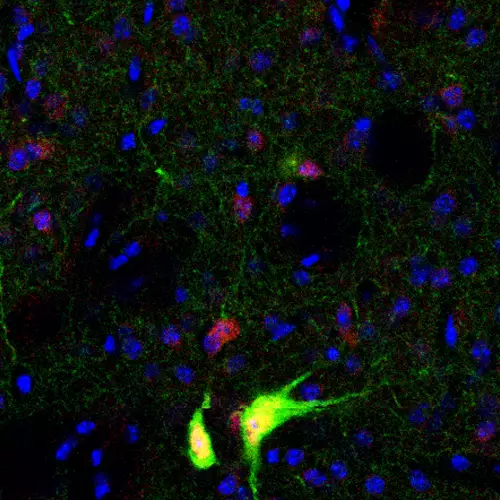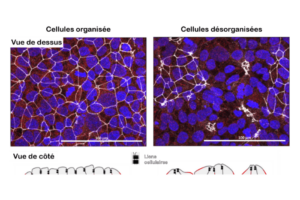Transcriptional regulatory networks in development and diseases
Our laboratory aims to understand the mechanisms that control normal development and how their deregulation causes disease, with a particular interest in the 19q12 deletion syndrome characterized by congenital malformations of the renal tract and autism spectrum disorder, which are associated to the haploinsufficiency of the gene TSHZ3.
Our laboratory aims to understand the mechanisms that control normal development and how their deregulation causes disease. We have identified a new chromosome 19q12 deletion syndrome (19q12DS). This syndrome is a rare genetic disease caused by the absence of one copy of the TSHZ3 gene. The most common symptoms in people with 19q12DS are congenital malformations of the renal tract (CAKUT) and autism spectrum disorder (ASD). ASD results from neurodevelopmental abnormalities. It is characterized by deficits in social interaction and restricted and repetitive behavior, interests or activities. The diagnosis of autism is primarily clinical and based on behavioral observations. To date, there is no treatment for ASD. As the pathophysiology of ASD is complex, we generated mice lacking one copy of the Tshz3 gene to model the syndrome. Characterization of these mice confirmed the presence of deficits in social interaction and repetitive behaviors and restricted fields of interest, as well as abnormalities of the urinary tract. Our main objective is to gain more knowledge about “where, when and how” the Tshz3 gene is essential for the development and function of certain neural circuits and the renal tract as a basis for the search for new treatment strategies.
To this end, we are performing a detailed molecular, cellular and behavioral characterization of new Tshz3 mouse models. This approach already led to the discovery that 1) postnatal deletion of Tshz3 in mice results in deficits in social interaction and repetitive behaviors and 2) the loss of function of Tshz3 in cortical projection neurons is responsible for social interaction deficits, whereas its loss in cholinergic interneurons in the striatum produces repetitive behavior.
Publications
Targeted Tshz3 deletion in corticostriatal circuit components segregates core autistic behaviors
Haploinsufficiency of the mouse Tshz3 gene leads to kidney defects
TSHZ3 deletion causes an autism syndrome and defects in cortical projection neurons
Teashirt 3 is necessary for ureteral smooth muscle differentiation downstream of SHH and BMP4
Three putative murine Teashirt orthologues specify trunk structures in Drosophila in the same way as the Drosophila teashirt gene
The gene teashirt is required for the development of Drosophila embryonic trunk segments and encodes a protein with widely spaced zinc finger motifs
Substrate stiffness alters layer architecture and biophysics of human induced pluripotent stem cells to modulate their differentiation potential
Glypican-4 serum levels are associated with cognitive dysfunction and vascular risk factors in Parkinson’s disease
Targeted Tshz3 deletion in corticostriatal circuit components segregates core autistic behaviors
Haploinsufficiency of the mouse Tshz3 gene leads to kidney defects
TSHZ3 deletion causes an autism syndrome and defects in cortical projection neurons
TSHZ3 and SOX9 Regulate the Timing of Smooth Muscle Cell Differentiation in the Ureter by Reducing Myocardin Activity.
The tiptop/teashirt genes regulate cell differentiation and renal physiology in Drosophila.
Tandem duplication of chromosomal segments is common in ovarian and breast cancer genomes.
Maintenance of antioxidant defenses of brain cells: plasma membrane glutamate transporters and beyond.
Toward a new role for plasma membrane sodium-dependent glutamate transporters of astrocytes: maintenance of antioxidant defenses beyond extracellular glutamate clearance.
Oxidative stress and prevention of the adaptive response to chronic iron overload in the brain of young adult rats exposed to a 150 kilohertz electromagnetic field.
Teashirt-3, a novel regulator of muscle differentiation, associates with BRG1-associated factor 57 (BAF57) to inhibit myogenin gene expression.
Teashirt 3 regulates development of neurons involved in both respiratory rhythm and airflow control.
Analysis of TSHZ2 and TSHZ3 genes in congenital pelvi-ureteric junction obstruction.
Teashirt 3 is necessary for ureteral smooth muscle differentiation downstream of SHH and BMP4
Tshz1 is required for axial skeleton, soft palate and middle ear development in mice.
Direct interaction between Teashirt and Sex combs reduced proteins, via Tsh’s acidic domain, is essential for specifying the identity of the prothorax in Drosophila.
Teashirt 3 expression in the chick embryo reveals a remarkable association with tendon development.
Chaetognath phylogenomics: a protostome with deuterostome-like development.
A critical role of teashirt for patterning the ventral epidermis is masked by ectopic expression of tiptop, a paralog of teashirt in Drosophila.
Restricted expression of a median Hox gene in the central nervous system of chaetognaths.
Expression patterns of the three Teashirt-related genes define specific boundaries in the developing and postnatal mouse forebrain.
Three putative murine Teashirt orthologues specify trunk structures in Drosophila in the same way as the Drosophila teashirt gene
Hox gene survey in the chaetognath Spadella cephaloptera: evolutionary implications.
Characterisation of set-1, a conserved PR/SET domain gene in Caenorhabditis elegans.
Grunge, related to human Atrophin-like proteins, has multiple functions in Drosophila development.
Cubitus interruptus acts to specify naked cuticle in the trunk of Drosophila embryos.
Vertebrate orthologues of the Drosophila region-specific patterning gene teashirt.
Characterization of the two zebrafish orthologues of the KAL-1 gene underlying X chromosome-linked Kallmann syndrome.
The role of Teashirt in proximal leg development in Drosophila: ectopic Teashirt expression reveals different cell behaviours in ventral and dorsal domains.
The levels of the bancal product, a Drosophila homologue of vertebrate hnRNP K protein, affect cell proliferation and apoptosis in imaginal disc cells.
The C-terminal domain of armadillo binds to hypophosphorylated teashirt to modulate wingless signalling in Drosophila.
Trunk-specific modulation of wingless signalling in Drosophila by teashirt binding to armadillo.
Transcriptional regulation of the Drosophila homeotic gene teashirt by the homeodomain protein Fushi tarazu.
GIF-DB, a WWW database on gene interactions involved in Drosophila melanogaster development.
The gene teashirt is required for the development of Drosophila embryonic trunk segments and encodes a protein with widely spaced zinc finger motifs
Monitoring positional information during oogenesis in adult Drosophila.
News
A touch of softness to facilitate differentiation of human induced pluripotent stem cells
Tuning of substrate stiffness enhances mesendoderm/endoderm hiPSC differentiation by modifying their epithelial properties.
Targeted Tshz3 deletion in corticostriatal circuit components segregates core autistic behaviors
Nos résultats apportent un éclairage nouveau sur l’implication du circuit corticostrié dans les TSA.
Data published in Hum Mol Genet. confirm that Tshz3 heterozygous mice constitute a model that replicates many of the clinical problems reported in patients with TSHZ3 heterozygous conditions.
No jobs opportunities found..



















